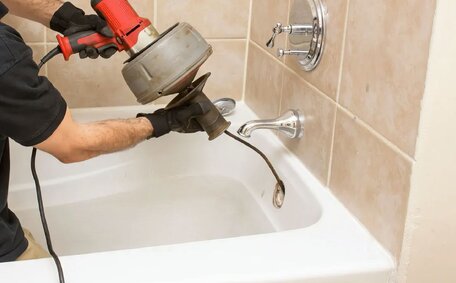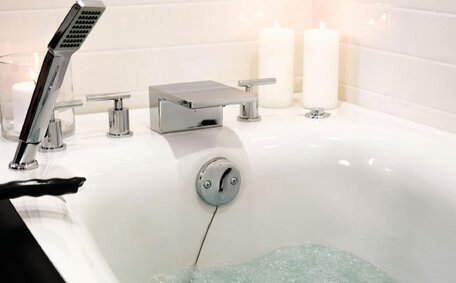The Importance of Regular Professional Plumbing Inspections
Regular professional plumbing inspections proactively address problems, helping to maintain and optimise plumbing performance. Annual or bi-annual inspections by skilled plumbers ensure minor issues in your system, such as drain, pipe, faucet, and fixture faults, are caught before they worsen. Detecting and addressing minor issues early can save you money and extend the lifespan of your home’s plumbing.
Experts can spot signs of wear and tear during an inspection, allowing for early intervention before issues escalate. This empowers them to recommend repairs, upgrades, or scheduled replacements that resolve problems before they worsen and keep everything in your house operating properly. Regular inspections provide peace of mind by confirming all plumbing issues are resolved, ensuring your system functions optimally.
Regular home plumbing inspections can help safeguard adequate water flow, pressure, and temperature for your needs. Inspections uncover hidden problems, like supply line leaks that may cause water wastage and damage. The aim is to ensure your plumbing remains safe and efficient for the long-term.
How Often Should Plumbing Inspections Occur?
Experts recommend annual inspections at a minimum for plumbing systems showing signs of wear, taking the system’s age into account. Annual check-ups allow plumbers to thoroughly inspect all components and address small issues before they become costly repairs.
You may need to schedule plumbing inspections more frequently for your commercial building’s requirements, especially in older properties where piping and fixtures tend to deteriorate faster. If your home’s plumbing is prone to tree root intrusion or pinhole leaks, consider biannual or quarterly inspections.
While new properties may only need yearly inspections, establishing a consistent checking routine from the outset is essential. Identifying and remedying minor wear and tear is essential for maintaining the integrity of the plumbing inside your residence for years ahead. This approach also safeguards against leaks, mould growth, and water damage, particularly in plumbing systems over 20 years old.
In the end, vigilant preventative maintenance saves money compared to emergency repairs after catastrophe strikes. Detecting issues promptly lets plumbers offer time and cost-efficient solutions, ensuring effective repairs. Regular inspections can help prevent future issues, providing peace of mind and ensuring your plumbing network functions safely and efficiently.
For Older Homes
Older homes often show enhanced wear and deterioration in their plumbing pipes. Piping can become brittle and corroded over time or develop hidden pinhole leaks. Outdated materials like galvanised steel or lead pipes need replacement for health and safety.
Older homes should have inspections at least biennially, or more often if needed. This helps catch small issues before catastrophic failures. Fixtures original to the home likely don’t meet current water efficiency standards, which plumbing services can modernise. More frequent inspections allow owners to upgrade problem components.
During inspections, plumbers assess gas lines and offer guidance on any compliance issues detected. Knowing the age of your plumbing system is crucial for strategic maintenance, helping to prolong its lifespan.
For Properties with Mature Trees
Properties surrounded by mature trees need plumbing inspections more frequently. As trees age, their root systems expand underground seeking moisture and nutrients, which can cause significant plumbing disruptions. Roots can infiltrate your main sewer line and drain lines, causing major blockages.
Experts suggest determining how often should your plumbing be inspected, advising biannually in properties with mature trees. An annual rooter service clears current root intrusions, and inspections can prevent future blockages from new root growth or vulnerable cracks. This prevention method averts major issues such as roots fully clogging the main sewer line over time.
A plumbing inspection can help check above ground for root damage. Buckling sidewalks, driveways or foundation walls may indicate underground pipe damage. Catching root issues early allows for pipe replacement before extensive destruction requiring costlier repairs.
When Moving Into a New Home
Scheduling a professional plumbing inspection is a smart move during the home-buying process, before finalising new homeownership. An in-depth appraisal of plumbing should accompany each new home acquisition, bringing to light any concerns about the supply lines, drainage, fixtures, and water pressure before completion of the sale.
Discovery of pre-existing plumbing problems post-move can result in expensive emergency repairs and stress. An inspection assures your new home’s plumbing is functional or highlights the need for credits towards essential upgrades.
Even brand new properties benefit from inspection. Experts can test water pressure, check piping connections, and ensure proper installation of all components. This prevents leaks, flooding, or other problems down the line due to construction defects.
Overall, plumbing inspection when moving into any new home reduces risk of unforeseen expenses and ensures your system functions optimally from day one. Identifying minor issues early is easier and more affordable to address too.
What a Professional Plumbing Inspection Entails
A professional plumbing inspection rigorously examines all plumbing components to pinpoint issues before they intensify. This includes extensive checks on all key components:
- Water supply lines
- Main water shutoff valve
- Fixtures like faucets, showerheads and toilets
- Pipes and joints
- Water heaters and the overall heating system
- Sump pump & drainage system
- Sewer lines & septic system (if applicable)
Inspection includes visual examinations, pressure tests, camera-assisted drain assessments, leak detection, and more. The goal is to thoroughly analyse if your plumbing is working properly and identify any current or potential faults.
An expert plumber will assess water pressure and flow at all fixtures, scan for exterior signs of leakage, and use specialised tools to examine the integrity of interior pipes and connections. Areas such as your water heater and pipes are closely examined for signs of corrosion, cracks, and outdated components.
By the inspection’s end, you’ll have a detailed report summarising system condition, required repairs, replacements needed, plus maintenance tips to optimise performance for more than just the short term. This protects against catastrophic failures down the line.
Visually Checking Fixtures and Pipes
As part of a plumbing inspection, the plumber conducts careful visual examinations of all accessible pipes, joints, valves and fixtures. This allows them to check for any exterior signs of leakage, corrosion, damage or wear.
Faucets and showerheads are scrutinised for drips or flow issues that could be due to hard water calcification or clogs. Toilets are checked for stability, flushing performance and water efficiency. The plumber examines exposed pipes and supply lines for problematic fittings, leaks at joints, rust spots or dents since your last inspection.
Minor issues such as worn washers, mineral buildup, or mild corrosion can indicate larger problems if ignored. Careful visual inspections are crucial for early identification of faults to prevent more extensive damage down the line.
Using Cameras to Inspect Drains and Sewer Lines
Plumbers use specialised cameras to thoroughly inspect the interior condition of underground drain and sewer lines. A flexible cable with a camera at the end is fed through plumbing pipes to identify any issues not evident from a visual check of fixtures.
The camera reveals corrosion, cracks, blockages from tree roots or debris, leaks, misaligned joints, and other problems. It broadcasts real-time images showing the exact location and severity of faults. This enables targeted repairs before small issues cause backups or pipe failures.
Sewer cameras find intrusions, like root overgrowth, early so pipes can be cleared or replaced if severely compromised. They also ensure that hot water is flowing properly without obstruction from high water pressure. Camera inspections provide definitive diagnosis of any underground drainage problems.
Testing Water Pressure and Flow
As part of a professional plumbing inspection, plumbers conduct thorough tests of Water pressure and flow at every fixture are crucial; issues such as slow drainage and low pressure, measured in PSI (pounds per square inch), indicate challenges with how strongly water flows through the supply lines. Experts measure pressure levels, as varying water pressure can very accurately signal the health of your plumbing system, ensuring the flow meets household requirements.
Standard water pressure ranges from 45 to 80 PSI. Pressure above 80 PSI can strain joints and valves, whereas pressure below 45 PSI may lead to inadequate flow from taps and showers. Abnormal pressure, such as low water pressure, signifies leaks, blockages, or other issues needing repair.
Flow rate testing measures water volume from fixtures over time. Plumbers examine flow at sinks, tubs, showers, and toilets checking for irregularity indicating piping problems. Low flow impedes usage while high flow strains drainage.
Pressure and flow tests jointly identify issues like slow drainage and low water pressure, ensuring the system meets usage needs. They identify leakage or obstructions so minor issues don’t become major leaks or backups. This preventative diagnostic is crucial to maintain optimal plumbing performance.
Importance of Follow-up Maintenance and Repairs
Beyond professional inspections, timely actions to maintain your system are equally important for peak performance. Addressing any identified issues or scheduled replacements promptly extends system lifespan and prevents minor problems from escalating over time.
Neglecting inspection outcomes, such as leaks, clogs, or signs of deterioration, can lead to scenarios where you’ll need plumbing repairs, water damage, or even flooding in the future. However, fixing problems early or performing recommended preventative maintenance can prevent issues and keeps everything functioning safely.
Think of inspection findings as a helpful to-do list for protecting plumbing integrity. Whether tackling repairs right away or budgeting for future scheduled upgrades, stay on top of suggested actions. The time invested and potential financial savings dwarf the expenses of emergency repairs after a disaster.
Ongoing maintenance aligns with inspection schedules too. Together, inspections help maintain plumbing in its prime condition.
Pairing annual drain cleaning with yearly inspections optimises your drainage system. Installation of protective pipe coatings or leak detection systems forms part of regular maintenance suggested from inspection tips.
Investing in Preventative Plumbing Maintenance
Investing in regular preventative plumbing maintenance pays dividends through reliability and cost savings. Routine steps, including yearly drain cleaning, pipe inspections, and sealing fixtures, prevent blockages and leaks, circumventing the need for costly emergency repairs.
Installing protective pipe coatings as part of annual plumbing maintenance shields from corrosion over time. Upgrading outdated fixtures improves water efficiency.
Swapping old pipe sections prone to root invasion or pinholes preempts catastrophic leakage. Even additions like backflow valves or leak detection systems guard against damage.
Though not compulsory, preventative measures are key to maintaining the integrity of your building’s plumbing system. It maximises operational lifespan through proactive care. The minor present cost secures major future savings and convenience.
Think of it as changing the oil in your car regularly despite no obvious issues. Why risk the headache of flooded basements or sewage backups when a little planning prevents plumbing catastrophes?
The Costs and Benefits of Professional Inspections
Hiring a plumbing company for professional inspections comes with upfront costs, but can save money over time by identifying issues early. Identifying minor issues early prevents costly emergency repairs later on.
A typical inspection ranges from $150-$300 depending on the property size and scope. Simple visual checks cost less, while camera inspections or pressure tests add to the price. Set against average costs of common repairs like:
- $500 to clear a main sewer clog
- $1500 to replace a burst pipe section
- $2000 for water heater replacement
Inspections deliver savings by avoiding such scenarios. Instead, minor leaks, joint issues or drainage clogs get addressed promptly and affordably. This extends the lifespan of plumbing too.
Over a 10 year period, inspection and preventative maintenance totals $2000-$4000, saving upwards of $10,000 over having to handle major repairs. And this doesn’t account for the indirect costs of property damage from undetected leakage or flooding.
Inspections also enhance efficiency by identifying high water usage from leaks or outmoded fixtures across your plumbing. Upgrading issues during scheduled maintenance minimises monthly water bills.
There’s also the peace of mind of knowing your plumbing works safely and effectively, backed by a detailed inspection report. Promptly addressing detected issues averts the inconvenience of sudden system failures.
Ultimately, regular professional plumbing inspection delivers multifaceted savings and system reliability over years of operation. Prioritising preventative maintenance is wise financial and practical plumbing management.






